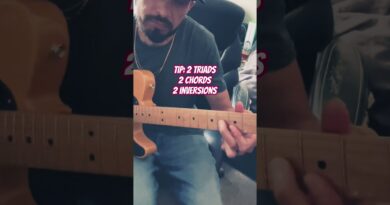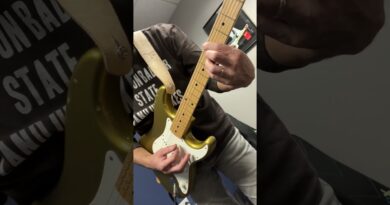BASS LINES: Triads & Inversions Part III
I first started playing an acoustic guitar in my band but now find myself working as the custodian of the groove in the bass department, plus keyboards, amplifiers and effects pedals akin to the bridge of the Starship Enterprise. What happened?
When I started off playing musical instruments as a child, life was simple.
There was the harmonica, my favourite sound to inspire random dogs to ‘howl’ along with a simple tune. Then followed descant and treble recorders, my friend Jill’s piano (and anybody else’s come to think of it), the school organ at lunchtimes and a brief awkward dalliance with a cheap violin. Finally, through Hobson’s choice, I settled on the last instrument standing in the school’s musical armoury – an old, unwanted and completely battered French horn. C’est la vie!
I really enjoyed this unusual curly-belled instrument and had lots of fun playing in the school orchestra and brass band, learning a lot about parts and how all the other instruments wove in and out of each other and the incredible melodies and emotions that followed. I was also a member of the school choir in the ‘alto’ department and fell in love with harmonies – it’s just the best!!
Sadly my dalliance with the world of brass had to stop with the installation of fixed ‘cheese-grater’ dental braces. Subsequently, I moved on to the acoustic guitar which allowed me a good deal of independence enabling me to sing and accompany myself with some cool chords. It also ignited my passion for songwriting.
Being heard
In the early 90s I moved to the north of England to study Media & Performance at Salford University and after singing some of my original songs in a lunchtime concert under the moniker of a band called I Never Used To Like Brussel Sprouts I ended up as one of the founding members of a contemporary folk band called Megiddo with some great guys off the degree course in Popular Music and Recording – namely John Smith, Tim Allen and Alan Lowles.
We wrote and performed all our original songs, self-recorded and released an album called On The Outside and toured the UK folk circuit. In those days if you wanted to test out new songs, a good place to go was our local folk club which was based in a pub in a slightly dodgy area in Higher Broughton.
There were no microphones or amplification of any kind – nothing electronic. Everything was acoustic and au natural. You listened to everyone else playing and when it was your turn – you stood up where you were sat – that was your stage.
Of course when we were booked for the bigger gigs we needed amplification for the instruments and vocals to be heard in these vast spaces – but we didn’t use any overt effects or added jiggery pokery with our instruments (two acoustic guitars and a fretless bass – we sounded natural – like us, but louder.

Credit: Steph Magenta ©1995
Megiddo (L-R Suzy Starlite, Tim Allen, John Smith, Alan Lowles)
A few years later, touched by the hand of fate – in a happy, groove-laden serendipitous happening – everything changed and I accidentally got hooked on playing the bass guitar.
I hadn’t been playing that long before my first professional gig, which happened to be with my husband Simon when we toured the UK to promote his second solo album, The Knife.

Credit: Stuart Bebb, Oxford Camera ©2023
Myself and Simon onstage at the Ramsbottom Festival 2015
Simon is a pro and I was in the band because he loved my playing.
As you know I didn’t start out playing bass as my first instrument and the funny thing is, a lot of other bass players didn’t either…
- Lemmy had just joined Hawkwind as a guitar player when he found out he was surplus to requirements due to Dave Brock deciding he was going to play lead guitar instead. But when the band’s bass player didn’t show up for one of their free gigs because he wasn’t getting paid, he had also inadvertently left his bass and amp in their van. So, Lemmy stepped in, and played bass for the first time live on stage at a gig! (That does make me laugh…)
- Flea from the Red Hot Chilli Peppers started out playing the trumpet and was pretty good at it too by all accounts.
- The Who’s thunderous John Entwistle started out on piano, then moved onto trumpet and French horn before he picked up a bass guitar. (Yey I played French Horn at school)
- Jaco Pastorius was first and foremost a drummer and only stopped playing after a wrist injury on the soccer field made it more difficult to play – that, and a better drummer had rocked up on the scene, so he stepped aside for this guy to take his place in the band. It was only because the bass player left at the same time that he picked up the bass!
- Carol Kaye played jazz guitar and by the knock of opportunity, moved onto bass when she filled in for a recording session when another musician didn’t show up!
- Tina Weymouth – who provided the bass-bedrock of Talking Heads signature sound, started out playing handbells – which has slightly freaked me out as I used to play them when I was a teenager too. Apparently, she taught herself guitar before picking up the bass when she formed the band with David Byrne and her now-husband, drummer Chris Frantz.
It’s all about the sound
Moving forward to today – music is not just about being heard anymore. I’m on a new and exciting trajectory, this time experimenting with my bass guitar making different sounds. From pedals to amplifiers to the big cabinets that house the speakers – you could say I’ve become a ‘cosmic explorer of the sonic palette’!
It sounds extra-terrestrial / inter-dimensional – and sometimes feels just like that!
In the beginning

My first bass guitar set up for the tour with Simon back in 2016 was simple: Mike Lull M4V bass guitar – plugged directly into my Sonic Research ST-300 TurboTuner (a guitar tuner) using the Supertone Mincap ‘A’ guitar cable then with a second cable to the back of the stage where it was plugged straight into an amplifier and speaker cabinet provided for me by the gigs/venues.
Since then I have had two different setups and have gradually added a few more bass guitars to my stable… Oh, and some stunning keyboards too.
What’s all the fuss about pedals?
What are guitar pedals and why use them?
This whole saga began in 2018 when we were touring our debut Starlite & Campbell album ‘Blueberry Pie’. Simon and I had formed a new band and had co-written and produced our first album together.
During the recording process, I played two different bass guitars. A Mike Lull M4V and a black Gretsch ThunderJet, both fitted with flat-wound strings.
You may not be familiar with these two beauties (check out the photos below) but as you would expect they have different sounds (aka tonal characteristics) and volumes (output levels), one being lower (quieter) than the other.
In the studio, you have time to set up each sound and when recording our first album together, Blueberry Pie, I needed a gritty, dirty, fuzzy sound for the solo section of You’re So Good For Me.
For this purpose, I employed the kickass assistance of the Supertone Custom Bass FUZZ by DWJ pedal – which I’ll explain more later – just know that I love it!!
FUZZ!!!!!!!

DWJ Supertone Bass FUZZ pedal
Photo credit: Simon Campbell
On tour, however, I needed to use this fuzz and swap between two different bass guitars for certain songs. This is where the wonders of technology, pedals and effects start to help you out.
Watch this video of our Starlite Campbell Band concert at The Met in Bury, Manchester to hear the ThunderJet in action. Geek alert: bass solo at 01:56 minutes.
Bass guitars
It’s probably a good place to give you some information on the two basses in question.
Gretsch ThunderJet
This was my first ever bass, chosen because I’ve got really small hands and it has a shorter neck – hence the term short-scale (shorter scale = smaller distance between the frets). I also wanted to have that short thumpy 60s sound, similar to Jack Bruce (Cream), Andy Fraser (Free) and Paul McCartney – (I think you may know which band).
The ThunderJet has a semi-hollow body so it’s not too heavy and has a big fat distinctive and punchy sound.
It’s also one of the best-looking sexy basses Gretsch has ever produced with a throwback to their vintage models and often people will ask me about it after gigs… upstaged or what?
Technical stuff
- Mahogany body with arched maple top
- Ebony fingerboard
- Semi-hollow body
- Dual TV Jones® Thunder’Tron™ pickups
- Space Control™ bass bridge
- 30.3-inch scale
- Thomastik-Infeld Jazz Bass – JF324 – flat wound strings

Gretch ThunderJet bass guitar
Photo credit: Simon Campbell
Mike Lull M4V
This guitar is ultra-special to me. Not only was it my wedding present from Simon but it was also made by the late great Mike Lull himself.
This is my old friend, the guitar I had imagined, which has been with me from almost the beginning, through endless hours of learning, making mistakes, jumping around with me when the music takes you high. We recorded most of the songs on Blueberry Pie with this bass and have played many a festival stage together, flown on planes and travelled around the world and back again.
The low end has a big attitude for rock and an elegant versatility that lets you slide up the neck as if you were on your knees sliding across a well-oiled floor! Sometimes I close my eyes and imagine it’s an upright double bass too, the sound and thud of the strings taking me to that smoky downtown bar.
The M4V evokes a fantastic classic vintage vibe with all the wonderful attributes of a 60/70s Jazz bass combined with passive electronics, all in a slightly downsized body shape.
Technical stuff
- Fitted with Hipshot Ultralite tuners with drop D
- Custom Wound Lindy Fralin Single Coil Pickups
- Hipshot Aluminium Bridge
- Mahogany Body
- Graphite Reinforced Maple Neck
- Rosewood fingerboard
- Thomastik-Infeld Jazz Bass – JF344 – flat wound strings

Mike Lull M4V bass guitar
Photo credit: Simon Campbell
Technical terminology/gear
At this juncture, I also needed to get my head around a few basic technical terms and learn about how things work.
What is that saying: It’s not easy because I haven’t learned it yet.
The guitar pick-up
Have you ever wondered how electric basses make sounds in the first place? It’s a fascinating process and the most important part of your electric guitar’s plugged-in tone. Below is a simple explanation:
- Guitar strings are made out of a magnetic metal.
- Underneath the strings sits the ‘pick up’ which is fitted into the body of the guitar.
- The pick up consists of a coil of wire wrapped around a magnetic pole piece (or pieces).
- When you pluck/hit a string – it vibrates which generates a voltage in the coil.
- In a passive bass (more of this later), the pickup(s) are directly connected to volume and tone controls which are then sent to the output of the instrument.
The signal chain
The signal chain is the order in which you place any effects/pedals. At first, I put my tuner first in the chain after the bass guitar the signal can be easily muted for silent tuning.
The pre-amp
This electronic device amplifies a weak signal, such as that from a passive bass.
These are found in bass/guitar amplifiers, studio mixing consoles, domestic HiFis, sometimes within the bass itself (referred to as an active bass) and as external units in the format of a pedal.
There are many different specifications but some are capable of driving a power amplifier (the second stage which amplifies this intermediate signal level to one which can drive a loudspeaker) and/or can be used before the amplifier to modify the sound, volume and tone of the instrument – I will explain more about this in the next instalment.
This brings me to the third pedal I owned.
Lehle RMI BassSwitch IQ DI

Photo credit: Simon Campbell
The Lehle RMI BassSwitch IQ DI was the centrepiece of my first pedalboard (a metal frame where all the pedals are organised). It was exactly what I needed at the time to help me sort out the technical challenges of playing two different basses with different sounds and volumes
The unit had two channels with separate volume controls enabling me to set the level for each bass by using a foot switch to select channel A or B.
Channel B also has very natural sounding tone controls (or equalisation – EQ) which allowed me to change the tone of the bass in channel B to complement the bass in channel A.
Two effects loops
The unit also has two effects (FX) loops, one switchable and one in all the time for both channels. In the switchable loop, I placed the FUZZ (so I could switch it in and out using the button on the Lehle) and my rarely used Ernie Ball volume pedal in the unswitched.
If you want to see the possibilities of routing and an explanation of FX loops, check out the manual.
The all-important mute switch
My tuner is connected to a dedicated ‘tuner output’ and the Lehle’s output can be muted via another footswitch.
As I mentioned at the beginning of the article, this mute is critical which enables me to tune up between songs silently as there’s nothing worse than someone audibly tuning up on stage – it’s messy and unprofessional.
The Direct Inject output
There are two outputs from the Lehle, one for the amplifier plus a very high-quality Direct Inject (DI) output which is compatible with mixing consoles, allowing the sound engineer to take the signals right from your pedals before they get to the amplifier.
My bass tone comes from the amplifier and speaker cabinet combination and I always insist it’s miked up for a performance.
There are some instances however that you need the signal to be sent to the live sound system (PA). For example, my Fylde King John acoustic bass is better using this direct method rather than going through the stage amplifier and again, more of this in the next edition!
It is a high-quality piece of kit that you come to expect from Lehle (although now sadly discontinued) and has never let me down. The only thing I have to watch out for is operator error when I’m wearing my big kickass ‘Boots of Rock’.
And finally…
I hope you enjoyed this article – if you have any questions or feedback, it would be cool to hear from you.
Next up in Walking the Bass Line – I’ll talk a little more about the role of the bass guitar, amplifiers, cabinets and another pedal.
British-born Suzy Starlite is a multifaceted artist known for her work as a bassist, singer, multi-instrumentalist, composer and multimedia artist. She co-owns Supertone, an independent record label and vintage analogue recording studio with her husband, guitarist and music producer Simon Campbell, based near Lisbon, Portugal. Their band, Starlite & Campbell, has released six studio albums and two live albums to date. Visit online at starlite-campbell.com/suzy-starlite, vibes.starlite-campbell.com/ and youtube.com/@starlitecampbell



